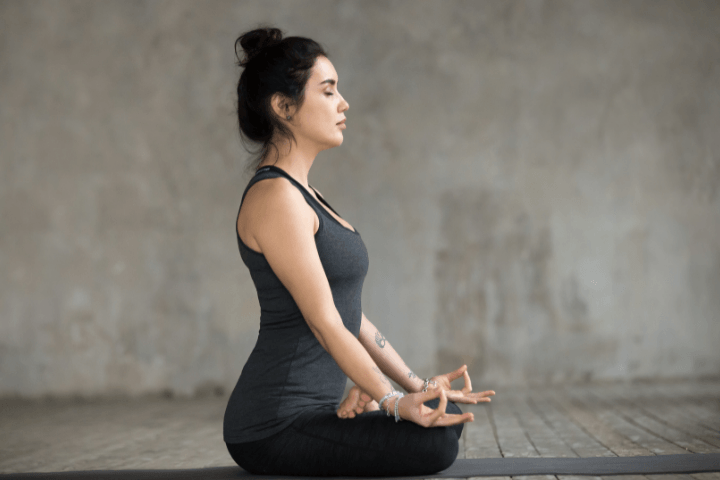
Yoga has been a part of our Indian culture since ancient times. Yoga asanas help you destress physically and mentally. One yoga asana that is quite popular and offers a multitude of health benefits is the Kapalbhati Pranayama.
What is Kapalbhati pranayama?
The meaning of the word Kapalbhati is quite simple. Kapal means ‘the skull’ and bhati means ‘to shine.’ The literal translation of the word means to improve your mental health and cleanse your mind. And the word pranayama means suggests that it is a ‘breathing technique’. This breathing practice helps you cleanse your mind and body and regularize your breathing.
What is the right way to practise the kapalbhati asan?
- Choose a quiet corner of your home, grab a yoga mat and sit down comfortably in a sukhasana.
- Place your hands on the knees with palms facing upwards. Fold the index finger of both hands so that it touches the thumbs.
- Breathe in through your nose.
- As you exhale, breathe out through your nose and pull your navel towards your spine. As you do this, place one hand on your stomach to feel your stomach muscles contract.
- You need to inhale when the stomach comes outwards and exhale when pulling the stomach inwards.
- Repeat the process a few more times, about 20 such breaths make one round of kapalbhati.
- Try and repeat the whole process about 4-5 times a day.
Some benefits of kapalbhati pranayama are:
- Kapalbhati helps to increase your lung capacity.
- The practise of kapalbhati pranayama helps remove toxins from our bodies.
- Kapalbhati's advantages also include improving our skin texture. Practicing this breathing improves skin health and gives a glow to it.
- These breathing exercises of Kapalbhati pranayama help in curing sinus and asthma
- It helps us get rid of acidity and heartburn.
- Kapalbhati improves blood circulation, digestion and helps improve the energy levels of the body.
- It can also help regularize periods and reduce menstrual cramps.
- It improves hair growth.
- Practicing kapalbhati pranayama can activate the chakras in our body.
- It also produces endorphins that help improve our moods.
Are there variations in Kapalbhati? If yes, how many?
There are essentially three types of Kapalbhati and these are as follows:
1.Vatakrama
Here, we sit on a yoga mat, crossed-legged on the floor. Our inhalation during this Kapalbhati procedure is passive and the exhalation is active
2.Vyutkrama
The process of Kapalbhati requires you to sniff in water from your nostrils and spit it back from your mouth.
3. Sheetkrama
In this practice, we take in water through our mouth and get it out through our nose. The process is quite opposite to the Vyutkrama Kapalbhati exercise.
When should you practice the Kapalbhati steps?
Kapalbhati pranayama must be practiced at the beginning of your yoga asanas. This keeps us energized for the rest of our practice and smoothens our breathing.
Frequently Asked Questions About Kapalbhati Pranayama
1. Who must avoid practicing Kapalbhati?
- Pregnant women must avoid this breathing practise.
- Never perform this breathing technique after having your meal.
- People with pacemakers, stents must avoid practicing kapalbhati.
- Anyone with a slip disc must avoid practising this breathing technique.
- To avoid doing this the wrong way, always learn to practise this technique through a yoga instructor or a practitioner. Additionally, it is recommended you do a health check-up before practicing kapalbhati.
2. Is Kapal Bhati pranayama dangerous to practise?
No, it is not but as mentioned above, people with health conditions must not practise the kapalbhati pranayama for safety reasons.
3. Can people with high blood pressure practise Kapal Bhati?
No, people with blood pressure must not practise this breathing technique.
4. How many rounds of kapalbhati pranayama should be done in a day?
20 breaths complete one round of kapalbhati. It is usually recommended that you do 4-5 rounds per day.
5. Can Kapalbhati help in reducing tummy fat?
Kapalbhati has variety of benefits when practised regularly. However, it must be practised in moderation and not specifically targeted towards to help you loose belly fat.
6. Can Kapal Bhati be practised even at night?
No, it is better to practise kapalbhati in the mronings or in the evenings. Additionally, it must be practiced 2-3 hours before consuming our food.
7. What are some of the extreme side effects of Kapalbhati?
Doing anything extreme can be harmful to our health and so is the case with kapalbhati. It must be practiced in moderation and by using the right techniques. If it is overdone, it can cause help problems like headache, high blood pressure and cause a hernia. Kapalbhati must also be practiced under supervision from a yoga instructor or practitioner.
8. Can kapalbhati actually cure liver diseases?
Regular practice of this breathing technique helps strengthen our liver.
Conclusion.
Kapalbhati pranayama is certainly one of the best breathing techniques for our mind, body and soul. It not only helps us stay healthy, but also helps us manage our weight and improves our breathing. It also helps us breathe correctly and keep a calm mind.
Along with practicing Kapalbhati pranayama, remember to sleep well on a good mattress and continuously hydrate yourself at regular intervals using a water bottle. These little practices are important to lead a healthy and a successful life.
Browse other interesting Health Tips :






























